Albany Teacher and Artist Showcase
November 18, 2023 | 10:00 am-12:00pm | FREE to attend
The Albany Institute of History and Art | 125 Washington Ave, Albany, NY 12210
Welcome to the CCC Showcase.
Experience important local artforms and learn what happened when educators included guest artists in their classrooms this fall.
Find out what students learned and enjoy artists’ sharing.
Thank you for attending today!
Meet the Artists
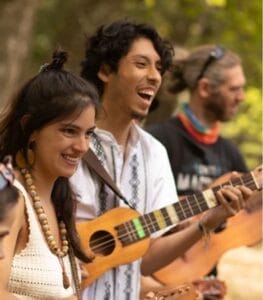
Pulso de Barro (Maria Puente Flores and Mateo Cano) Maria Puente Flores – I was born and raised in Mexico City, but I am currently living in upstate New York (very grateful to be surrounded by forests and rivers). My mom says I was already singing before I could even talk. Yet, despite my love for songs and music, I had always felt very intimidated by instruments. That changed when Son Jarocho became a part of my life. Son Jarocho is a folk genre from the state of Veracruz in Mexico, and people gather to play it in community celebrations called Fandangos. My first Fandango took place under a tree in Central Park in NYC. One of the musicians came up to me and gave me a jarana (a stringed instrument that looks like a small guitar). They taught me a couple of chords and suddenly I became part of the music. Filled with joy and excitement by that experience, I learnt little by little the traditional verses that are sung – now I can even compose my own! – and I also learnt the zapateado which is the dance that also functions as the percussion of the music. Being part of the Son Jarocho community demonstrated to me that I can play many instruments, but most importantly, it surrounded me with people who make me feel closer to my home in Mexico.
Mateo Cano – I am a Mexican American teaching artist and I have always loved a good story. I remember my mom telling me stories in Mexico, where I was raised, about amazing people with tremendous courage and I remember being inspired and in awe. Now I am a storyteller and I tell stories through my body with dance, through sounds with music, and in any way I can come up with! Throughout my life I have moved a lot from place to place — changing schools, states, and even countries almost every couple of years. All the changes made me realize that there are an astonishing number of good stories everywhere, so eventually I developed a keen skill for listening to what others had to say.

Altin Stoja I grew up in Albania. There, the church and nature were like a playground for me. When I was a kid, I had two passions: to play outside and to paint. I saw the paintings and murals in the church, and they inspired me to paint. When I was old enough, I went to school to become an artist. I learned to paint iconography with a master artist in Greece. Icons are traditional, symbolic paintings of biblical stories. I also paint pomegranates, sunflowers, and beautiful landscapes of places where I like to be outside. It was my dream to paint. It took me many years to master my art. I have been painting for more than 30 years. I made many mistakes, and many beautiful pieces of art too. I have lived in Albania, Greece, and now in America. I speak the language of each country. Now I open my eyes and I see my dream become reality. The Saint Sophia Orthodox Church in Albany is filled with my paintings.
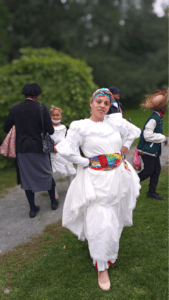
Shelyan Madera I was born in Ponce, Puerto Rico. At a young age, my parents were my inspiration. My father is an artist and a musician. He loves to sing, play the piano, and paint things that remind him of Puerto Rico. My mother is also a talented musician who likes to sing music that represents our Puerto Rican culture. She also caters traditional food. My parents taught me everything that I know about our culture. They told me to educate and teach others our traditions to keep our culture alive. Now I teach young people to dance Bomba y Plena, an important form of traditional Puerto Rican music and dance. I also educate them about the history of this dance. The roots of Bomba y Plena came from West Africa in the 1600s, particularly from Angola and Congo. In La Bomba Puertorriquena two women and a man dance to different rhythms of the drums. Some of the dances are called Sika, Lero, Coembe, Kalinda, Hollandes, and Yuba. The African dance and music traditions behind Bomba y Plena were to have fun, to congregate in religious belief, and to communicate with others. My goals are to teach my students to feel culture through the sound of the drums and let them come into my circle to create harmony and freedom, to keep the music alive.

Jianling Yue The art of Chinese paper cut is deeply rooted in rich cultural and regional backgrounds, carrying multiple layers of meaning, normally some auspicious meaning and good wishes. Since it is customary for people in northern China to make and paste paper cut on doors and windows, I naturally learned the skill from neighbors in my hometown in Shanxi Province, China, a region abundant in Chinese paper cut culture and other folk traditions. When I was in school, during the break time, boys played outside the classroom while girls stayed inside, making Chinese paper cuts, chatting, and exchanging pattern designs. Later I joined a teacher training school, refined my techniques through a course focusing on hand crafts which included paper cut. I also started to create my own designs which have expanded contents and themes and diverse color palette.
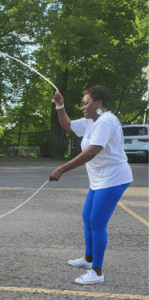
Natalie Jay-Short I am the founder and coach of Nanny’s Double Dutch League. I teach kids and grown-ups the skill of jumping Double Dutch competitively. It’s not only for girls, boys jump as well. It takes two people to turn two ropes in a circular motion and one or two people to jump in the rope. When I was in third grade, my gym teacher asked a group of us if we wanted to learn Double Dutch and compete in a tournament. I jumped Double Dutch from third grade to high school. I won many trophies, jackets, and even savings bonds!
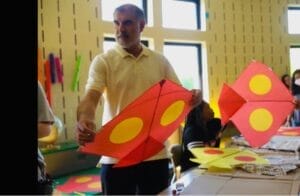
Ahmad Shah Wali I grew up in Kabul, Afghanistan. The weather is more or less like Albany. During the winter we used to make and fly kites. When I was a little boy, I was very active and adventurous. I was always outside, making and flying kites. I spent time with family, learning the skill to make kites. Those were the most memorable activities of my childhood. When I came to the United States in 2017, I found out that there are some limited activities in terms of kite flying. I therefore decided to teach my kids and other kids how to fly. Flying a kite is one of the most exhilarating experiences a child or an adult can have. A sense of pride, joy, and accomplishment washes over them as their eyes watch this object that they built fly into the sky. Flying kites helps family bonding. What better way to spend a weekend afternoon than building and flying a kite together? Regardless of your participation level in kite flying, there really is nothing sweeter than spending an afternoon in the great outdoors with your kids.
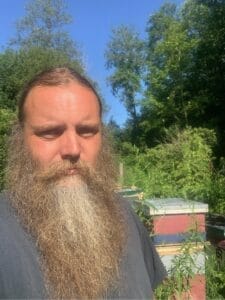
Scott Hart My beekeeping started a while ago as a child observing bees work on a dairy farm that a relative owned. Beekeeping has always been something that tugged at my soul. Fast forward 30-ish years, I decided to get a couple of hives. The second year of having bees is what really changed how I looked at and thought about bees. I did not like using chemicals in my hives. This thought is actually what changed my beekeeping mindset from science to an art. I want to say a few things about bees and what non-beekeepers can do. People should not be scared of honeybees! They are very docile little critters. Without honeybees, our food supply would disappear. One of the best ways people can help honeybees and other insects is to leave a patch of lawn to grow wildflowers. Mowing lawns at a half-inch is probably one of the worst things we humans can do. There is a rising community of beekeepers who want to go back to a simpler way of beekeeping. What I hope to share and give back is spreading the word about what I have done with genetics and management. Treatment-free beekeeping is a very difficult thing to do, but it is also very rewarding.

The Desi Trio Our trio is made up of Daniel Wilayat, Aurelius John and Shaman Raphael. For all three of us music is a fundamental part of life. Music was present in our families and in our communities as part of religious and social events. We all have experienced teaching music in Pakistan and in the US. We perform traditional Pakistani and Indian music from the Asian Subcontinent. We perform religious and popular music like Sufi songs, Ghazals, classical and folk music. The songs we perform are sung in many different languages; Urdu, Punjabi, Pashto, Sindhi and Balochi spoken by the people in the region.The instruments we play are traditional ones for these styles of music and include the Harmonium (pump organ), Bansuri Flute, and many types of drums; Dhol, Dholak, and Tabla.
Thank you for Attending the Culture, Community, and the Classroom showcase! This program happens because of the support of many important funders and individuals like yourself. Please consider donating to support these programs.
About the project
Twelve teachers in school districts around the region participated in a summer workshop with nationally recognized faculty from Local Learning: The National Network for Folk Arts in Education. Eight educators were selected to host artists in their schools. Learn from these local teachers and traditional artists who participated in this national initiative to incorporate diverse cultural arts and knowledge into classrooms in a lively showcase. Learn more about the summer workshop here.
Thank you to these funders who made it possible to offer this as a free professional development opportunity for teachers and artists: The National Endowment for the Arts, New York State Council on the Arts, and individual donors to Local Learning.
We are grateful to our local colleagues Maxwell Kofi Donkor and Alex Torres for their help in planning this professional development series. We want to acknowledge the support of Ellen McHale and New York Folklore, Greater Capital Region Teacher Center, and the Albany Institute of History and Art.

